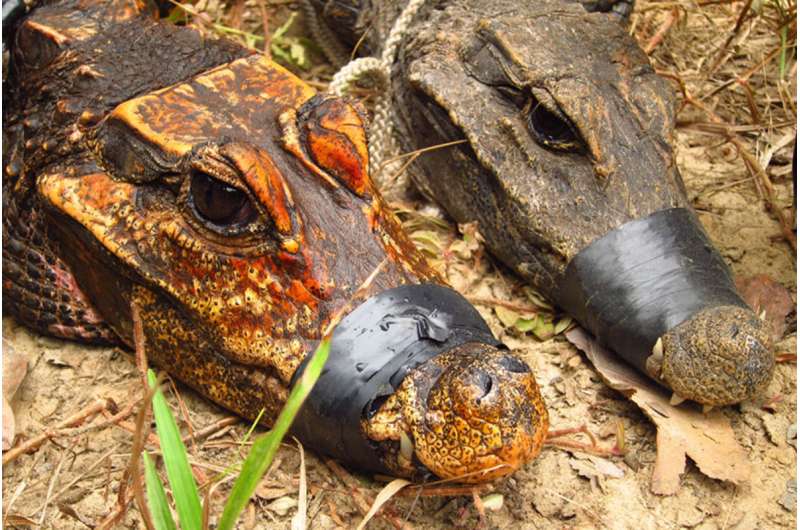January 31, 2018 report
Strange orange cave dwelling African dwarf crocodiles could be evolving into a new species

A team of researchers with affiliations to institutions in the U.S., France, Cameroon and Gabon has found evidence that suggests that orange dwarf crocodiles living in caves in Gabon might be evolving into a new species. In their paper published in the African Journal of Ecology, the group describes their study of the unique crocodiles and their attempts to compare them with similar crocodiles living just outside the cave, and what they found by doing so.
The orange dwarf crocodiles living in Abanda caves in Gabon were first discovered back in 2008 and confirmed in 2010. Soon thereafter, it was discovered that older specimens had an orange hue due to the acidity of the bat guano in the water in which they lived. But what intrigued the members of this team was the crocs' differences from their relatives still living just outside the caves.
A prior expedition had discovered that at least some of the younger and smaller dwarf crocs made their way outside of the caves each spring to mate and produce young, but it is still unclear if the larger crocs are also able to do so. Prior expedition teams had also found that the crocs lived by eating bats and crickets, which is notably different from those that live just outside—they eat fish and other crustaceans. Another issue on the minds of the explorers was whether the cave-dwelling crocs are evolving into a new species. To find out, they captured several specimens and put them through genetic testing. They found that the crocs were passing along a unique haplotype in their DNA, an indicator of possible evolutionary change.
One factor that might be holding up such evolution, however, is the ability to breed in the cave—those crocodiles that live around the cave but not in it, reproduce by laying eggs in rotting vegetation. There is no such vegetation in the cave, which means the crocs must still leave the cave to reproduce, or they have found an as-yet undiscovered way to lay eggs that will survive in the dark, murky cave.
More information: Matthew H. Shirley et al. Diet and body condition of cave-dwelling dwarf crocodiles (Osteolaemus tetraspis , Cope 1861) in Gabon, African Journal of Ecology (2016). DOI: 10.1111/aje.12365
Abstract
We present the first ever observations of dwarf crocodiles (Osteolaemus tetraspis) selectively utilizing a cave ecosystem. We analysed crocodile diet to preliminarily assess the degree of ecological isolation of cave-dwelling crocodiles from their forest-dwelling conspecifics despite their physical proximity. We additionally conducted the first study of body condition of dwarf crocodiles and compared cave-dwelling individuals to surface-dwelling individuals from a variety of alternative habitats and sites as a means to better understand the implications of a semihypogean life on this species. Crocodiles captured in the caves appeared to forage exclusively in the caves and ate mostly cave crickets and bats, whereas crocodiles captured in the surrounding forest habitat consumed primarily freshwater crustaceans and insects and were not found to consume cave-dwelling prey. Juvenile cave crocodiles had significantly higher body condition compared to juvenile forest crocodiles, which did not vary amongst forest locations. The difference in body condition between adult cave and forest crocodiles was not statistically significant despite also being higher; we suspect this is an artefact of the low sample size rather than a real nondifference. Forest adult crocodiles generally had significantly higher body condition than juveniles, but did not vary by site or habitat. This lack of variation suggests that habitat type is not the most important factor influencing dwarf crocodile body condition. Our results provide a unique insight into facultative cave use by a principally surface-dwelling species and reinforce the necessity for further research into this unique system to better understand the evolutionary-scale implications of cave habitat use by dwarf crocodiles.
© 2018 Phys.org


















